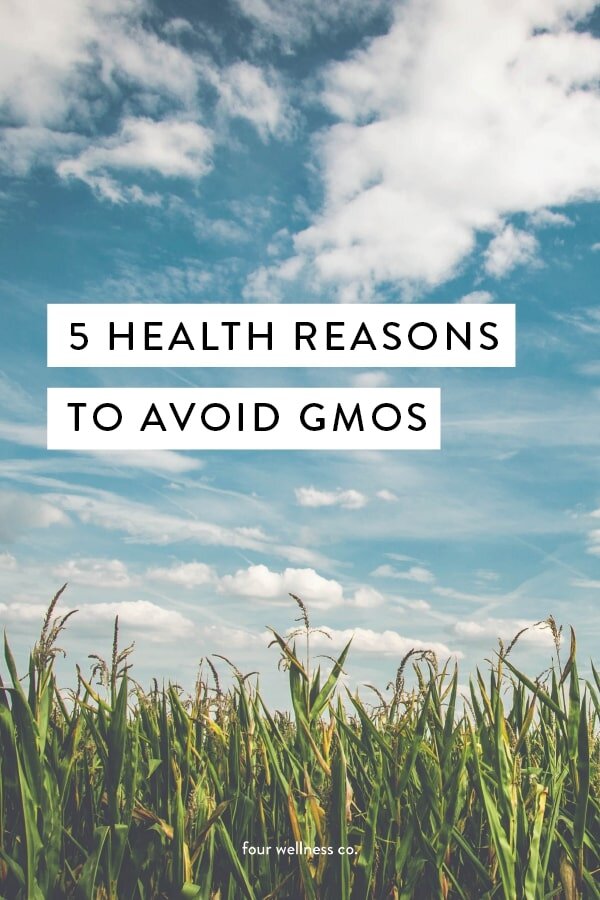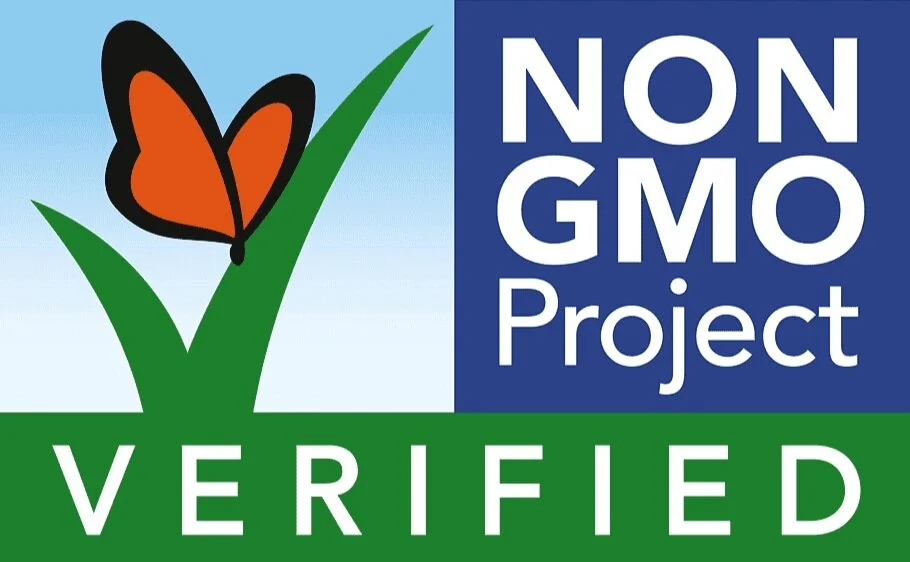GMOs: Benefits, Risks & Why We Avoid Them
GMOs (genetically modified organisms)* are crops that are genetically engineered to withstand direct application of herbicide and/or to produce insecticide themselves.
*GMOs can be any living organism modified for any purpose, but the ones you hear so much about these days are commercial crops.
Genetically modified (GM) crops have been modified for many different purposes, including the ability to withstand environmental threats, such as drought and frost, as well as pests, viruses and herbicide application (so weeds can be sprayed without killing the crop). These modifications are typically intended to increase yield.
Genetic engineering is also sometimes used to enhance a crop’s nutrient profile (like golden rice), increase growth rate or increase its shelf life. However, most commercialized GMOs are insecticide-producing and/or herbicide-tolerant plants.
How genetic engineering works
An organism’s genome is modified by deleting, mutating or inserting genes. In most commercial cases, new DNA is inserted from another organism, in order to produce the desired traits.
GMOs’ rise in popularity… and concern
Introduced commercially in the mid-1990s, GM crops quickly became popular because of the increased pest resistance and growth rates they promised.
Twenty years later, GMOs are omnipresent: 88–95% of U.S. corn, soy, canola, sugar and cotton plants are genetically modified.
Though the general public was essentially unaware of the growth of GMOs over the past 20 years, consumer awareness has grown recently. The lack of transparency surrounding GMO product testing and marketing has gained national attention and led to growing skepticism of GM foods: a recent poll shows that 57% of Americans believe that GMO foods are unsafe.
GMO foods are implicated in a range of health concerns, including food allergies, gastrointestinal disorders, skin conditions, fatigue, ADD/ADHD and neurological problems.
Still, mainstream science and media contest most of these claims, as the most prominent studies of GMO food safety show that there are no adverse health effects over the period of study.
However, given the relatively sudden pervasiveness of GMOs in the American diet, combined with the lack of long-term scientific study on humans (especially study funded outside the biotech industry), it’s understandable that GM foods have not yet demonstrated long-term health implications. If they are chronically toxic (like cigarettes), rather than acutely toxic (like cyanide), it will take time to tell what their effects are.
GMO labeling, please
Because the limited testing of GMO foods means that there is still some uncertainty regarding their safety for human consumption over the course of a lifetime, some sources recommend a precautionary approach—avoid until further notice.
Since being cautious about GMOs requires being able to recognize them, many science and health experts, as well as two-thirds of the general public, support mandatory GMO labeling. As you may know, this has been a significant national debate.
Major food and chemical companies have spent millions opposing GMO labeling requirements, as they believe it would scare consumers and hurt sales—and, sure enough, polls show that 57% of Americans would be less likely to buy food labeled as genetically modified.
Mandatory GMO labeling was introduced in 84 bills in 29 states before it first passed in Vermont in 2014. (As with other food legislation, this issue was closely tied to fundraising—while pro-labeling efforts are typically led by small NGOs, opposition to labeling is backed by trillion-dollar food and chemical industries.)
As U.S. labeling legislation loomed, large American food companies began to quietly re-formulate their products without GMO ingredients, as top food execs envisioned a future in which consumers are more aware of and less supportive of GMO products. “Non-GMO” is one of the fastest-growing label trends on U.S. food packages; increasingly, consumers want to know if their foods contain GMOs, and some producers are taking advantage of the opportunity.
Although Americans have been unknowingly consuming GMOs for two decades, the recent rise in awareness and skepticism has showed potential to hurt sales, and companies are responding. Businesses shift to meet consumer demand—which is why it’s incredibly important to vote with your dollar for the types of foods you would like to have access to.
The USDA’s GMO labeling policy
For many years, the USDA has not supported mandatory labeling, on the grounds that the current scientific consensus finds no detectable difference between GM foods and conventional foods, and therefore there is no reason to label a difference. Yet while the U.S. government has assured consumers that there’s no need to be aware of if/when you’re eating a genetically modified product, 64 countries and the EU already require GMO labeling. While acknowledging the consensus that GMO foods are “not un-safe” for human consumption in the short-term, the EU adopted a precautionary approach due to the uncertainty of the long-term effects not yet tested for.
In 2016, Congress passed the National Bioengineered Food Disclosure Standard requiring the USDA to establish rules for labeling foods that contain genetically modified ingredients. These rules were to be established by July 2018.
It’s not yet clear what’s happening with this, though it seems that the labels would use the term “BE” (bioengineered) instead of GM or GMO. The USDA is currently being sued over failure to meet the deadline set in the law. So, at this time, the U.S. does not have an official GMO labeling policy… though there might be one on the horizon.
Health reasons to avoid GMOs
In light of the available research, we suggest avoiding GMOs “for now”—there’s not enough research showing that they’re safe in the long-term (consumption over a lifetime), and enough reason to believe they may not be. This suggestion is especially emphasized for anyone with gastrointestinal or neurological conditions.
Here are five health reasons why we recommend avoiding GMOs:
Avoid consuming insecticides
Potential health effects of consuming insecticides range from food allergies and gastrointestinal issues to neurological problems.
Bt, the insecticide toxin produced by many GM crops, is linked to damage in the intestinal wall, causing digestive problems such as intestinal permeability, food allergies and autoimmune responses. These reactions to Bt are also suggested to be a contributor to the recent rise in gluten intolerance.
Note: Bt is a naturally occurring bacterium approved as an insecticidal spray for organic crops, for which it has been widely used for decades. Bt degrades quickly in sunlight, so Bt-sprayed crops contain only trace amounts of the bacterium, whereas crops genetically engineered to produce Bt contain it in every cell. If you’re wondering, Bt kills insects by making their stomachs burst.
More herbicide = more side effects
Increased herbicide use needed by GM crops’ tolerance to direct herbicide application has resulted in resistant “superweeds” that in turn demand even more herbicide. Due to increased spraying, GM foods have been found to contain higher herbicide residues, which are linked to hormone disruption, birth defects, sterility and cancer.
Limited research on long-term health outcomes
Studies of GMO safety are based on limited-term health impact research, mostly funded by the same companies profiting from selling these foods; this is of questionable trustworthiness for judging these products’ long-term health effects.
Hints from history: don’t look to Monsanto for health advice
Monsanto, the world’s largest producer of genetically engineered seed (and corresponding herbicides), assures the public that GMO crops are safe to eat. Monsanto also formerly assured the public that DDT, Agent Orange, and PCBs were safe, all of which were proven not to be, after widespread health and environmental damage. In other words, they’re not really a trustworthy source for health advice.
Eat real food
Genetically modified crops engineered to include pesticides don’t quite fit into our most central rule of nutrition: eat real food. As a basic rule of thumb, it’s healthiest to eat real foods that have been part of the human diet for longer than you can remember. Seems simplistic, but it’s one of the basic rules for a healthy digestive system—we do best eating foods our digestive system evolved to digest.
Healthy Kitchen Guide
We love healthy food and healthy cookware. (Did you know that some kitchen supplies are made of materials that can leach toxins into your food?)
Grab our Healthy Kitchen Guide, part of our Wellness Library of healthy living guides + resources. It covers:
✔️ what your cookware is made of (and why that matters)
✔️ the best types of nontoxic cookware
✔️ tips + tricks for healthy food prep, cooking and storage
✔️ a Healthy Kitchen Checklist for your own home
How to avoid GMOs
Unfortunately, avoiding GMO foods (if that’s what you’re interested in doing for the time being) is harder than you may imagine. An estimated 70% of food in American grocery stores contain GM ingredients, and they’re not labeled.
Here are some tips for avoiding GMOs, if you so choose:
Avoid processed foods, as 80% of processed foods in the U.S. contain GMOs.
Buy organic—the organic certification process does not allow GM ingredients (and there are many other benefits of eating organic too!).
In particular, choose organic corn, soy, canola and sugar products (these are the highest risk crops, and also present in a wide range of processed food products).
Also select only organically-raised meat and animal products (conventionally-raised animals are fed primarily corn and soy, which are very likely to be genetically modified).
Look for the Non-GMO Project seal, which means that the product was verified through an independent third-party process.
Buy from producers you know and trust, or grow your own!
GMOs aren’t all bad
So, if GMOs are so horrible, why do some people still support them?
Some cite the glory of golden rice and other genetically engineered crops that serve as a solution to hunger and malnutrition around the world. We agree that golden rice is pretty cool! And so are drought-resistant GM crops that bring food security and economic growth to poor and famine-stricken regions.
But that’s not what we’re eating here. In the U.S., we don’t eat golden rice. We are not starving because our millet crop failed in the East African drought. We’re eating insecticides.
The American GMO argument is not simply about genetic engineering (which, as a whole, is arguably a good thing).
It’s about using genetic engineering in food crops, in a way that is potentially harmful, while not being transparent about research methods and safety concerns, and denying the public the right to know how their food was produced.
The future will likely hold a place for genetically modified crops across the world. So, the current issue is our need to distinguish between the benefits of developing and promoting GM crops that improve health and livelihood, while also being realistic that perhaps some GM crops don’t provide significant enough advantage to be worth their adverse health effects.
FOUR WELLNESS TIP
When grocery shopping, be conscious of selecting non-GMO products (use the list above for reference!).













